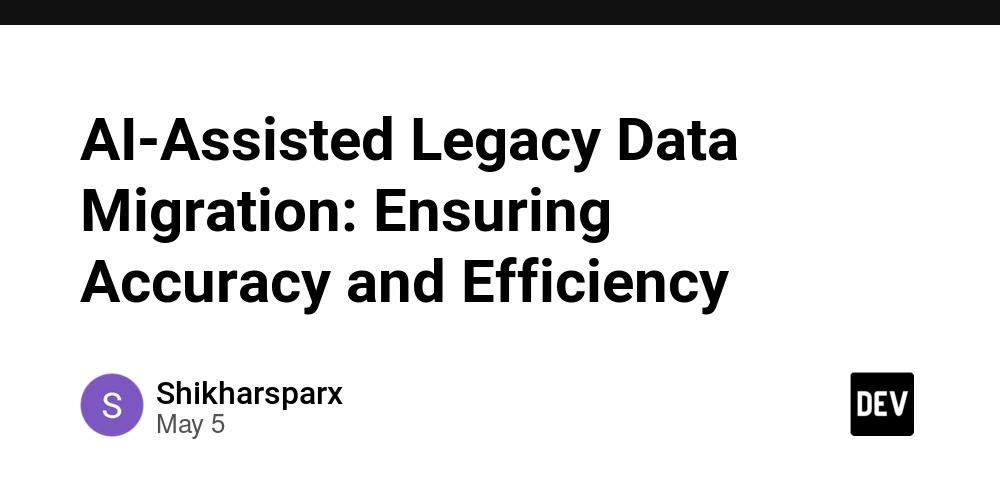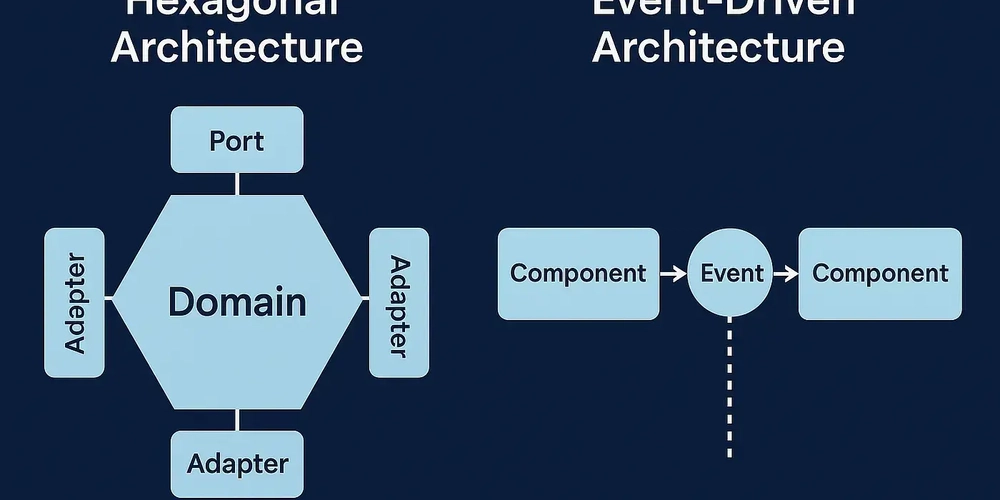AI-Assisted Legacy Data Migration: Ensuring Accuracy and Efficiency
As organizations seek to modernize their operations, migrating data from outdated systems to modern platforms has become a critical task. Legacy systems often contain vast amounts of valuable data, but transferring this data can be fraught with challenges, including data loss, inaccuracies, and extended migration times. Fortunately, advancements in artificial intelligence are transforming the data migration process, ensuring accuracy and efficiency while minimizing risks. This article explores how AI tools can assist in migrating data from legacy systems to modern platforms. Understanding Legacy Data Migration It refers to the process of transferring data from outdated systems to new, modern platforms. This process is essential for organizations looking to leverage the benefits of modern technologies, such as improved performance, enhanced security, and better integration capabilities. However, migrating data from legacy systems can be complex due to various factors, including data formats, system compatibility, and the sheer volume of data involved. Common Challenges in Data Migration - Data Quality Issues: Legacy systems often contain outdated, incomplete, or inconsistent data, making it challenging to ensure data quality during migration. - Data Loss Risks: The risk of data loss during migration is a significant concern. If not managed properly, critical information may be lost or corrupted during the transfer process. - Extended Migration Times: Traditional data migration methods can be time-consuming, leading to prolonged downtime and disruptions to business operations. The Role of AI in Data Migration 1. Data Assessment and Profiling AI tools can assist organizations in assessing and profiling legacy data before migration. By analyzing the existing data, AI algorithms can identify data quality issues, inconsistencies, and redundancies. This assessment allows organizations to address potential problems before the migration process begins. Benefits of Data Assessment - Improved Data Quality: AI can help organizations clean and validate data, ensuring that only accurate and relevant information is migrated to the new system. - Informed Decision-Making: Understanding the state of legacy data enables organizations to make informed decisions about what data to migrate and how to structure it in the new system. 2. Automated Data Mapping Data mapping is a critical step in the migration process, as it involves defining how data from the legacy system will be transformed and stored in the new platform. AI tools can automate this process by analyzing data structures and relationships, making it easier to create accurate mappings. Advantages of Automated Data Mapping - Efficiency: Automating data mapping reduces the time and effort required to manually map data fields, speeding up the migration process. - Accuracy: AI algorithms can identify and resolve discrepancies between legacy and modern data structures, minimizing the risk of errors during migration. 3. Intelligent Data Transformation During migration, data often needs to be transformed to fit the requirements of the new system. AI can facilitate intelligent data transformation by applying predefined rules and algorithms to ensure that data is accurately converted to the appropriate format. Benefits of Intelligent Data Transformation - Consistency: AI ensures that data is consistently transformed according to established rules, reducing the likelihood of errors and inconsistencies. - Real-Time Processing: AI tools can process data in real-time, allowing organizations to monitor the transformation process and make adjustments as needed. 4. Continuous Monitoring and Validation AI tools can continuously monitor the data migration process, providing real-time insights into the status of the migration. This monitoring allows organizations to identify and address issues as they arise, ensuring a smoother migration experience. Importance of Continuous Monitoring - Early Issue Detection: AI can quickly identify anomalies or discrepancies during migration, allowing organizations to take corrective action before data loss occurs. - Validation of Data Integrity: After migration, AI tools can validate the integrity of the migrated data, ensuring that it matches the original data and meets quality standards. Conclusion AI-assisted legacy data migration offers organizations a powerful solution for ensuring accuracy and efficiency in the data transfer process. By leveraging AI tools for data assessment, automated mapping, intelligent transformation, and continuous monitoring, businesses can minimize the risks associated with data migration while optimizing the overall process. As organizations continue to modernize their systems, embracing AI in data migration will be essential for achieving successful legacy system modernization.

As organizations seek to modernize their operations, migrating data from outdated systems to modern platforms has become a critical task. Legacy systems often contain vast amounts of valuable data, but transferring this data can be fraught with challenges, including data loss, inaccuracies, and extended migration times.
Fortunately, advancements in artificial intelligence are transforming the data migration process, ensuring accuracy and efficiency while minimizing risks. This article explores how AI tools can assist in migrating data from legacy systems to modern platforms.
Understanding Legacy Data Migration
It refers to the process of transferring data from outdated systems to new, modern platforms. This process is essential for organizations looking to leverage the benefits of modern technologies, such as improved performance, enhanced security, and better integration capabilities.
However, migrating data from legacy systems can be complex due to various factors, including data formats, system compatibility, and the sheer volume of data involved.
Common Challenges in Data Migration
- Data Quality Issues: Legacy systems often contain outdated, incomplete, or inconsistent data, making it challenging to ensure data quality during migration.
- Data Loss Risks: The risk of data loss during migration is a significant concern. If not managed properly, critical information may be lost or corrupted during the transfer process.
- Extended Migration Times: Traditional data migration methods can be time-consuming, leading to prolonged downtime and disruptions to business operations.
The Role of AI in Data Migration
1. Data Assessment and Profiling
AI tools can assist organizations in assessing and profiling legacy data before migration. By analyzing the existing data, AI algorithms can identify data quality issues, inconsistencies, and redundancies. This assessment allows organizations to address potential problems before the migration process begins.
Benefits of Data Assessment
- Improved Data Quality: AI can help organizations clean and validate data, ensuring that only accurate and relevant information is migrated to the new system.
- Informed Decision-Making: Understanding the state of legacy data enables organizations to make informed decisions about what data to migrate and how to structure it in the new system.
2. Automated Data Mapping
Data mapping is a critical step in the migration process, as it involves defining how data from the legacy system will be transformed and stored in the new platform. AI tools can automate this process by analyzing data structures and relationships, making it easier to create accurate mappings.
Advantages of Automated Data Mapping
- Efficiency: Automating data mapping reduces the time and effort required to manually map data fields, speeding up the migration process.
- Accuracy: AI algorithms can identify and resolve discrepancies between legacy and modern data structures, minimizing the risk of errors during migration.
3. Intelligent Data Transformation
During migration, data often needs to be transformed to fit the requirements of the new system. AI can facilitate intelligent data transformation by applying predefined rules and algorithms to ensure that data is accurately converted to the appropriate format.
Benefits of Intelligent Data Transformation
- Consistency: AI ensures that data is consistently transformed according to established rules, reducing the likelihood of errors and inconsistencies.
- Real-Time Processing: AI tools can process data in real-time, allowing organizations to monitor the transformation process and make adjustments as needed.
4. Continuous Monitoring and Validation
AI tools can continuously monitor the data migration process, providing real-time insights into the status of the migration. This monitoring allows organizations to identify and address issues as they arise, ensuring a smoother migration experience.
Importance of Continuous Monitoring
- Early Issue Detection: AI can quickly identify anomalies or discrepancies during migration, allowing organizations to take corrective action before data loss occurs.
- Validation of Data Integrity: After migration, AI tools can validate the integrity of the migrated data, ensuring that it matches the original data and meets quality standards.
Conclusion
AI-assisted legacy data migration offers organizations a powerful solution for ensuring accuracy and efficiency in the data transfer process. By leveraging AI tools for data assessment, automated mapping, intelligent transformation, and continuous monitoring, businesses can minimize the risks associated with data migration while optimizing the overall process.
As organizations continue to modernize their systems, embracing AI in data migration will be essential for achieving successful legacy system modernization. By ensuring that valuable data is accurately and efficiently transferred to modern platforms, organizations can unlock new opportunities for growth and innovation in an increasingly digital landscape.











































































![New Apple iPad mini 7 On Sale for $399! [Lowest Price Ever]](https://www.iclarified.com/images/news/96096/96096/96096-640.jpg)
![Apple Developing Battery Case for iPhone 17 Air Amid Battery Life Concerns [Report]](https://www.iclarified.com/images/news/97208/97208/97208-640.jpg)
![Apple to Split iPhone Launches Across Fall and Spring in Major Shakeup [Report]](https://www.iclarified.com/images/news/97211/97211/97211-640.jpg)
![Apple to Move Camera to Top Left, Hide Face ID Under Display in iPhone 18 Pro Redesign [Report]](https://www.iclarified.com/images/news/97212/97212/97212-640.jpg)











![The Material 3 Expressive redesign of Google Clock leaks out [Gallery]](https://i0.wp.com/9to5google.com/wp-content/uploads/sites/4/2024/03/Google-Clock-v2.jpg?resize=1200%2C628&quality=82&strip=all&ssl=1)
![What Google Messages features are rolling out [May 2025]](https://i0.wp.com/9to5google.com/wp-content/uploads/sites/4/2023/12/google-messages-name-cover.png?resize=1200%2C628&quality=82&strip=all&ssl=1)

































































































_Inge_Johnsson-Alamy.jpg?width=1280&auto=webp&quality=80&disable=upscale#)


























































































































![[The AI Show Episode 145]: OpenAI Releases o3 and o4-mini, AI Is Causing “Quiet Layoffs,” Executive Order on Youth AI Education & GPT-4o’s Controversial Update](https://www.marketingaiinstitute.com/hubfs/ep%20145%20cover.png)











































































































































![Re-designing a Git/development workflow with best practices [closed]](https://i.postimg.cc/tRvBYcrt/branching-example.jpg)




















![From Art School Drop-out to Microsoft Engineer with Shashi Lo [Podcast #170]](https://cdn.hashnode.com/res/hashnode/image/upload/v1746203291209/439bf16b-c820-4fe8-b69e-94d80533b2df.png?#)



![[DEALS] Microsoft 365: 1-Year Subscription (Family/Up to 6 Users) (23% off) & Other Deals Up To 98% Off – Offers End Soon!](https://www.javacodegeeks.com/wp-content/uploads/2012/12/jcg-logo.jpg)
































































































